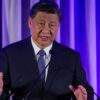Technology
Intel CEO Lip-Bu Tan has a protracted monitor document within the chip business. Now he wishes a heavy buyer
Intel’s CEO Lip-Bu Tan speaks on the corporate’s Annual Production Era Convention in San Jose, California, U.S. April 29, 2025.
Laure Andrillon | Reuters
When Lip-Bu Tan used to be named CEO of Intel a tiny over two months in the past, he introduced with him enough quantity of brand name popularity. Tan spent 12 years operating Cadence Design Programs and prior to that used to be a well-known undertaking capitalist. He’s additionally held board seats at SoftBank and Hewlett Packard Endeavor.
“Lip-Bu’s Rolodex is like nobody else’s in the semiconductor industry,” Intel CFO David Zinsner stated at a monetary convention this presen. Zinsner stated Tan just lately met with 22 doable consumers and companions in one month.
At year 65, Tan goes to want greater than a giant database of contacts and 4 many years of running and making an investment enjoy to show across the corporate that put the silicon in Silicon Valley however is suffering to stick related in a marketplace that’s increasingly more focused round synthetic judgement.
As soon as the arena’s greatest chipmaker, Intel has misplaced 70% of its price since early 2020. It’s more or less flat since Tan used to be named as CEO on March 12.
Tan’s jam-packed agenda in massive section displays a wish to alternate the business’s belief of Intel. Now not the dominant participant in semiconductors, Intel is attempting to pivot into chip production, particularly because the U.S. specializes in making an investment in onshoring crucial applied sciences. Tan has been taking note of consumers to determine particular technical necessities they would want from Intel as a foundry, he’s stated in family remarks.
Beneath Tan’s predecessor, Pat Gelsinger, Intel spent $90 billion between 2021 and 2024 on construction the corporate’s foundry operations and unlocking extra U.S. executive investment. Capital expenditures in 2025 are anticipated to achieve $18 billion.
Buyers, and sooner or later the board, misplaced believe in Gelsinger’s skill to generate a lot of a go back on that funding, prominent to his ouster past due terminating yr. In an business the place roadmaps and capital plans are deliberate in five-year increments, Tan is underneath power to start out construction self belief in an instant.
“The foundry business, it operates at a different time scale,” stated Alvin Nguyen, an analyst at Forrester. “It operates with a level of investment that is tough to stomach, and very few publicly traded companies can deal with it.”
Intel faces a enough quantity of alternative demanding situations that each one predate Tan’s tenure. The corporate’s central processors, or CPUs, that for many years had been the most costly and noteceable section in computer systems, were supplanted through AI chips, basically graphics processing gadgets, or GPUs, from Nvidia. In the meantime, Complicated Micro Gadgets has picked up really extensive marketplace proportion in CPUs and server chips, and Qualcomm has emerged as a heavy challenger as neatly.
Tan is operating on an AI technique underneath Sachin Katti, who used to be named eminent generation officer in April later becoming a member of the corporate in 2021.
Tan used to be born in Malaysia and raised in Singapore. He moved to the U.S. within the Nineteen Seventies and studied nuclear engineering on the Massachusetts Institute of Era. He’s since touched with regards to each and every side of the chip business.
Prior to becoming a member of Intel, he used to be CEO of Cadence, which makes digital design automation, or EDA, tool, broadly worn through engineers at fabless chip firms to design unused processors. As a undertaking capitalist at Walden World, Tan invested in Semiconductor Production World Company, China’s nationwide foundry, in 2001, and used to be at the board for over a decade.
He’s now making a bet on Intel, no longer simply together with his presen but in addition his pockets. When he become CEO, he purchased $25 million of stocks, which he’ll must secure to bring to earn his complete reimbursement over the upcoming 5 years.
Tan has been retaining a reasonably low profile since establishing the gig in March. He’s but to sit down for a press interview, and Intel declined to create Tan to be had for this tale. However in his two family speeches as CEO at Intel occasions, he’s laid out parts of his technique.
“We need to do a better job — make it easier for all of you to use our technology,” Tan stated at a foundry tournament previous this presen. “We will rapidly embrace industrial standards, EDA tools and best design practices.”
One heavy buyer
The quickest method to alternate the trajectory can be to announce a heavy foundry buyer. Locking in really extensive orders would handover as each a vote of approbation to alternative doable consumers and a sign to Wall Side road that each one the ones bills will quickly get started becoming earnings.
“One Nvidia, one Qualcomm, one Apple, one something of volume that really shows this meaningful commitment for the fab to build significant volume would really change the whole narrative,” said Daniel Newman, CEO of industry research firm The Futurum Group.
Tan’s second public appearance as CEO came in April at Intel’s Foundry Direct Connect event in San Jose, California, a few miles from the company’s headquarters. There he hinted at one of his key objectives: rebuilding confidence.
“This is a truly a service business, and that is built on the foundational principle of trust,” Tan said. “You have to be patient to earn your trust.”
Intel wafers are displayed on stage at the company’s Annual Manufacturing Technology Conference in San Jose, California, U.S. April 29, 2025.
Laure Andrillon | Reuters
At the event, populated largely by people from the insular world of chip design and manufacturing, Tan directly addressed foundry customers, discussing the company’s specific technologies in power and packaging that put it in position to take on Taiwan Semiconductor Manufacturing Company, the largest foundry in the world.
Outside the convention center, banners still hung promoting the Nvidia GTC conference, which had taken place the prior month and packed the building’s ballroom.
Tan mostly acted like an emcee, calling up the CEOs of chip design partners such as Synopsys, Cadence and Siemens, who took the stage to discuss using Intel’s technology.
A key issue for Intel to address is the broadening of its foundry, which was originally designed for its own chip design teams, meaning some of the tools and infrastructure were company-specific. Intel has given the name 18A to its chip technology that it hopes to start producing in volume this year.
“One thing about 18A was, it was developed initially as just something for Intel, and we intercepted it relatively early,” Zinsner said earlier this month. That allowed the company to develop process design kits, or PDKs, “for the industry, but it still was not from the ground up developed as a foundry node,” he said.
Zinsner said the company’s next chip generation, 14A, will be built for external customers. Analysts say that 18A may be Intel’s first foundry process that could beat TSMC’s rival process to market.
Tan also recognizes that TSMC has created an industry standard, so using the same tools and technology would allow companies to more simply bring over work from other foundries. He said Intel is making its PDK easier to use.
“My top priority is to make it easier for the ecosystem to do business with Intel,” he said.
One of the speakers at the event was Anirudh Devgan, who succeeded Tan as CEO of Cadence. Tan asked Devgan what AI chip companies need to see if they’re to build on Intel. Devgan said the most important consideration is the need to focus on what the customer wants rather than what Intel prefers.
“Intel Foundry, as you all know, is like the service business, so the customer comes first,” Devgan said. “I know Lip-Bu has very good instincts to understand what the customer wants.”
It’s a stark change in approach for a company that for decades was focused on selling its own chips and not on creating an ecosystem. In a podcast earlier this year, TSMC founder Morris Chang said that Intel, all the way through its glory years, acted “like they were the only guy with microprocessors.”
If there used to be a unhappiness on the Intel tournament, it used to be the insufficiency of a press release a few main unused buyer.
Zinsner in the past stated, in keeping with a query about what number of consumers Intel had signed up for its foundry, that the corporate first must “eat its own dogfood,” indicating that the 18A procedure can be basically worn through Intel itself.
Leaner corporate
Occasion Tan appears to be like outward for trade building, he’s turning inward to attempt to recovery company tradition, pulling down the group, which grew fiercely lately because it staffed as much as develop the foundry unit.
Intel stated on its April income name that process cuts will come this quarter, although the corporate didn’t handover a particular quantity. An Intel consultant declined to remark at the topic. Intel introduced in August, month Gelsinger used to be nonetheless in rate, that it used to be shedding 15,000 staff and would discover cuts in its portfolio.
Wall Side road welcomes extra belt tightening however warns that the corporate can’t scale down its method to a a success revival.
Deutsche Vault’s Ross Seymour, who recommends protecting the reserve, wrote in a Would possibly word that, even with the “welcome and necessary cost-cutting actions,” the corporate’s “path to meaningful earnings/free cash flow generation remains cloudy and highly dependent on a turnaround” within the foundry trade.
Similarly noteceable to Tan is eliminating what he perspectives as remaining paperwork.
“It has been eye-opening for me to see how much time and energy is spent on internal administrative work that does not move our business forward,” Tan wrote, in a memo to staff in April.
He stated Intel must discover ways to do extra with fewer community and that staff should be again within the place of job for a minimum of 4 days a day through September.
“I’ve been surprised to learn that, in recent years, the most important KPI for many managers at Intel has been the size of their teams,” Tan wrote, relating to key efficiency signs. “Going forward, this will not be the case.”
Tan additionally promoted a number of engineering leaders, giving him higher visibility into the group. Zinsner stated Tan has between 15 and 17 direct studies, as a result of he desires to be nearer to the “lowest” ranges of the group.
“He’s hearing the good, the bad, the ugly of what’s going on, so that he can help address those,” Zinsner stated.
WATCH: Intel is useless cash in its stream strategic method, says Susquehanna Rolland






